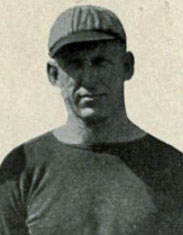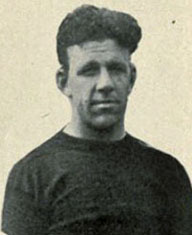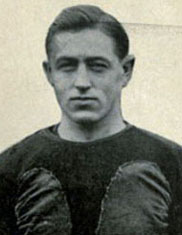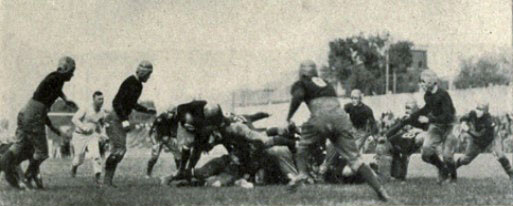Clash of Titans
Games featuring a future Hall of Fame coach on each sideline.
October 8, 1921: Notre Dame @ Iowa
Knute Rockne vs Howard Jones
Hawkeyes Pull Upset
Howard Jones played end for three seasons (1905-07) at Yale during which the Bulldogs never lost a game, going 28-0-2. The Eli claimed the national championship all three seasons.
Right out of college, Jones became head coach at Syracuse for the 1908 season. Then he returned to Yale for the '09 campaign before moving again to Ohio State for 1910. He then entered private business for four of the next five years, with another stint at his alma mater for 1913.
He became head coach at Iowa in 1916. The Iowa Board of Control of Athletics tasked Jones not only with mentoring the players he had but also with scouting for prospective athletes throughout the state in order to build a team that could win the Western Conference.
The Hawkeyes went 23-14-1 in his first five seasons. Along the way, the Board made him the Athletic Director. They also signed him to a new five-year contract in 1919.
By 1921, Jones felt he had a squad that could compete for the Western Conference championship. His effort to keep Iowa football prospects in state had succeeded. Every member of the starting line up was an Iowan. All the players from the tall corn country had the stamina to play the entire game if needed. As a result, only 13 members of the squad saw enough game time to earn a letter.
Featured Player
Duke Slater was one of the first Black players to win All-America honors. He earned a spot at tackle on Iowa's all-time honor team and was inducted into the Halls of Fame of both the National Football Foundation and the Helms Athletic Foundation.
He was born in 1898 in Illinois, the son of a Methodist minister. The family moved to Clinton, Iowa, in 1911 where Rev. Slater became pastor of the Methodist church.
The elder Slater would not give his strapping son permission to go out for football at Clinton High because he didn't want him to get hurt. Duke defied his father, but dad discovered what his son had done when he saw his wife sewing rips in the boy's football uniform.
Duke went on a hunger strike for several days until his father changed his mind, reluctantly acquiescing with the condition that his son must avoid injury. Inevitably, Duke took his lumps on the field but was careful not to limp or complain around dad.
|  Fred "Duke" Slater |
Each player had to provide his own helmet and shoes. Reverend Slater said he could not afford to buy both, so Duke played all his high school games without a helmet and continued that habit at Iowa.
When Duke's father received compliments from neighbors about Duke's football ability, he attended his first game and became a big fan.
Slater entered Iowa on a football scholarship in 1918, Howard Jones's third season as head coach of the Hawkeyes.
After the Illinois game of 1919, nationally-recognized football commentator Walter Eckersall wrote: "Iowa's line outplayed the Illinois forwards while Les Belding was a stone wall for Iowa on his end. Slater, the giant (215 pounds) tackle, was strong throughout. He broke up Illinois plays time after time and frequently followed around behind the line and caught the runners from behind."
The following season, Eckersall wrote this: "In Slater, Iowa has one of the best forwards in the country. This man is one of the most powerful players seen since the days of Joe Curtis of Michigan, Walker of Minnesota and Buck of Wisconsin. He is so powerful that one man cannot handle him, and opposing teams have found it necessary to send two men against him every time a play was sent off his side of the line."
Fritz Crisler, later a Hall of Fame coach at Michigan, was an end at Illinois when he played against Slater. He commented: "Duke Slater was the best tackle I ever played against. I tried to block him throughout my college career, but never once did I impede his progress to the ball carrier."
Slater helped the Hawkeyes finish 5-2 in both 1919 and 1920. He would make an even greater impact in 1921. |
|
After a 52-14 romp over Knox College to start the 1921 season, the Hawkeyes turned their attention to the game the entire state had been waiting for – the visit of Knute Rockne's Notre Dame team. Reputed to be even stronger than the 9-0 team of 1920, the South Bend contingent had two warmup games under its belt – a 56-0 romp over Kalamazoo College and a 57-10 rout of DePauw. Those wins extended Notre Dame's winning streak to an unprecedented 20 games.
Notre Dame was not yet called the "Fighting Irish." Even the South Bend news-times did not use that term. The Iowa City Press-Citizen referred to Notre Dame as "the Catholics" in its gameday article. "Fighting Irish" did not become the official nickname of the Notre Dame's athletic teams until 1927.



L-R: Coach Howard Jones, Gordon Locke, Aubrey Devine
(University of Iowa Hawkeye Yearbook Class of 1923)
Iowa Draws First Blood
The Hawkeyes took the opening kickoff and drove to a touchdown. Powerful junior FB Gordon Locke and senior captain and QB Aubrey Devine, a run and pass threat, took turns hammering at the Notre Dame line behind the superb blocking of Slater and other linemen until the ball was at the Notre Dame two on fourth down. Locke took the snap, took one step to his right, then hit between left tackle and guard. Slater was to block the Notre Dame guard while E Glenn Devine blocked the tackle out.
"I never saw such an example of ballcarrying," Aubrey Devine recalled later. "With two yards to go for a touchdown, Slater missed his block on 'Hunk' Anderson, but Locke swerved just enough to keep 'Hunk' from hitting him head on." That swerve enabled Locke's momentum to carry him over the goal line despite being in Anderson's grasp.
Senior Heartley "Hunk" Anderson, an Iowa native, was Notre Dame's captain (and future Iowa head coach). Rockne would call Anderson "the greatest lineman I ever coached." An outstanding blocker and sure tackler, Anderson would gain a spot on Walter Camp's 1921 All-American team.
After scoring the touchdown, human battering ram Locke got up slightly confused and wanted to fight the entire Notre Dame team. So Jones sent in a substitute for him. "All players played the full 60 minutes of that game except Gordon," recalled Aubrey Devine. The extra point to make it 7-0 Iowa.
Later in the first quarter, Iowa drove into Notre Dame territory again. This time the visitors forced Aubrey Devine to try a field goal on fourth down. He dropkicked the ball from the 42 between the posts to extend the Hawkeyes' lead to 10-0.
Devine said, "I figured from that position I might as well dropkick as punt. I looked up just as the ball was going over the bar!"
Notre Dame Closes the Gap
Notre Dame started moving the ball on Johnny Mohardt's 18y run around right end and good gains by Danny Coughlin and Chet Wynne. The drive continued to the Iowa 25 as the quarter ended.
Notre Dame soon had the ball back at midfield and this time reached the end zone when Mohardt threw to E Roger Kiley who took it on the 30 and zipped to pay dirt. Anderson served as a decoy on the play, taking the Hawkeye defense to the left while Kiley hesitated, then shot out to the right. Buck Shaw's conversion cut Iowa's lead to 10-7.
Late in the second quarter, the visitors started another march into Iowa territory. From the 25, Mohardt connected with Anderson to the five. But the Hawkeyes threw up a stone wall and gave up just 4y on three runs. So Notre Dame tried a pass on fourth down, but it was intercepted in the end zone by Locke, who ran it to midfield before Mohardt tackled him.
Anderson recalled, "Even by halftime, we had murdered Iowa statistically. Referring to our frequent fumbles, in the dressing room Rock told us, 'I thought you guys were going to get penalized for abusing the ball!'"

Gordon Locke carries for Iowa. (University of Iowa Hawkeye Yearbook Class of 1923)
Iowa Hangs On
The second half was nerve-wracking for Iowa fans. Jones turned conservative and ordered immediate punts out of danger each time Notre Dame bogged down in Hawkeye territory. Aubrey Devine launched booming kicks on which Slater was first down the field to smother the returner, speedy Frank Thomas, before he could get up a head of steam.
Iowa threatened again in the second half following an intercepted pass by Aubrey Devine, who ran the ball to the six. But Notre Dame pushed the Hawkeyes back to the 28.
Paul Castner made his first appearance of the season for Notre Dame and boomed a 70y punt that put Iowa on the defensive the rest of the game.
Notre Dame threatened when Grant, Coughlin, and Lieb carried the ball to the Iowa eight as the third quarter ended. But the Hawkeyes kept the visitors out of the end zone.
After Iowa punted out of danger, Castner missed a 50y field goal by 5y.
The Hawkeyes punted again to midfield. Mohardt connected with Kiley and Anderson to put the pigskin on the 14. But Lester Belding intercepted the next pass.
Gus Desch ran back another punt into Hawkeye territory. But Iowa pushed the visitors back to the 20 to force a fourth-down pass that Belding snagged again.

Locke plunges as Slater (on the ground without a helmet next to Locke) blocks out three defenders.
Kiley blocked a kick and ran the ball to the 25 where Devine caught him by one leg. Mohardt's pass to Anderson put the ball on the eight. But a fourth down pass was intercepted.
Rockne sent in several substitutes in the last minutes in an effort to turn the tide.
In the waning seconds, Castner took a pass for a 33y gain to the 17 as time ran out.
FINAL SCORE: IOWA 10 NOTRE DAME 7
Postgame
Notre Dame outgained Iowa by more than two to one.
The upset of Notre Dame was victory #5 in a 20-game undefeated string that began with the fifth game in 1920 and extended to the fourth game of 1923.
Three Hawkeyes made the 1921 All-America team: Slater, Aubrey Devine, and Locke.
Jones later rated Devine as the best all-purpose back he ever coached.
References
Notre Dame Football Review 1921
The Hawkeyes: University of Iowa Football, Chuck Bright (1982)
Greatest Moments in Iowa Hawkeyes Football History, Kindle Edition, The Cedar Rapids Gazette (2006)
Notre Dame Football Review 1921
The Hawkeyes: University of Iowa Football, Chuck Bright (1982)
Greatest Moments in Iowa Hawkeyes Football History, Kindle Edition, The Cedar Rapids Gazette (2006)